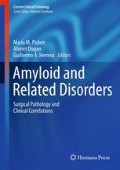Abstract
After diagnosing amyloid by the Congo red procedure (see Chap. 13), identifying the chemical nature of the amyloidotic protein causing the disease is mandatory for therapeutic considerations. Here is illustrated how immunohistochemical typing of amyloid can be achieved on formalin-fixed tissue sections using a panel of amyloid antibodies which were produced for this purpose. These antibodies and the histological expert evaluation are the key for a successful amyloid typing while the various pitfalls are being avoided. The single strong, consistent, and therefore diagnostic reaction has to be distinguished from the other weaker, inconsistent, and unspecific reactions since amyloid deposits contain various substances. The prevalence of the amyloid types among 626 samples submitted for typing is presented. Other laboratories have achieved similar results with these antibodies since this typing is easy, fast, and affordable. Finally, mass spectrometry has confirmed the high sensitivity and precision of this routine method for classifying amyloid.
Access this chapter
Tax calculation will be finalised at checkout
Purchases are for personal use only
Notes
- 1.
AIg is proposed here as a practical acronym for the combination of AL and AH.
References
Sipe JD, Benson MD, Buxbaum JN, Ikeda S, Merlini G, Saraiva MJ, Westermark P. Amyloid fibril protein nomenclature: 2010 recommendations from the nomenclature committee of the International Society of Amyloidosis. Amyloid. 2010;17:101–4.
Merlini G, Westermark P. The systemic amyloidoses: clearer understanding of the molecular mechanisms offer hope for more effective therapies. J Int Med. 2004;255:159–78.
Lavatelli F, Perlman DH, Spencer B, Prokaeva T, McComb ME, Théberge R, Conners LH, Belotti V, Sheldin DC, Merlini G, Skinner N, Cortello CE. Amyloidogenic and associated proteins in systemic amyloidosis proteome of adipose tissue. Mol Cell Proteomics. 2008;7:1570–83.
Linke RP. Congo red staining of amyloid. Improvements and practical guide for a more precise diagnosis of amyloid and the different amyloidoses. In: Uversky VN, Fink AL, editors. Protein Misfolding, aggregation and conformational diseases, Protein reviews, Volume 4, (MZ Atassi, editor); Chapter 11.1, pp. 239–76; Springer 2006.
Schroeder R, Deckert M, Linke RP. Novel isolated cerebral ALλ (lamda) amyloid angiopathy with widespread subcortical distribution and leukoencephalopathy due to atypical monoclonal plasma cell proliferation, and terminal systemic gammopathy. J Neuropath Exp Neurol. 2009;68:286–99.
Murphy CL, Wang S, Williams T, Weiss DT, Solomon A. Characterization of systemic amyloid deposits by mass spectrometry. Methods Enzymol. 2006;412: 48–62.
Vrana JA, Gamez JD, Madden BJ, Theis JD, Bergen 3rd HR, Dogan A. Classification of amyloidosis by laser micro dissection and mass spectrometry based proteomic analysis in clinical biopsy specimens. Blood. 2009;114(24):4957–9.
Linke RP, Oos R, Wiegel NM, Nathrath WBJ. Classification of amyloidosis: misdiagnosing by way of incomplete immunohistochemistry and how to prevent it. Acta Histochem. 2006;108:197–208.
Picken MM, Herrera GA. The burden of “sticky” amyloid: typing challenges. Arch Pathol Lab Med. 2007;131:850–1.
Linke RP. Classifying of amyloid on fixed tissue sections for routine use by validated immunohistochemistry. Amyloid. 2011;18 Suppl1, 67–70.
Linke RP, Joswig R, Murphy CL, Wang S, Zhou H, Gross U, Rocken C, Westermark P, Weiss DT, Solomon A. Senile seminal vesicle amyloid is derived from semenogelin I. J Lab Clin Med. 2005;145:87–193.
Linke RP, Adler S, Hegenbart U, Schönland S, Gröne HJ. Chronic, slowly progressing nephropathy due to amyloid of cSAA (SAA4) origin. Abstract XIth Internat. Symposium on Amyloidosis, Nov. 5–9, 2006 Woodshole, MA/USA.
Wiegel NM, Mentele R, Kellermann J, Meyer L, Riess H, Linke RP. ALκ (kappa)(I) (UNK)—primary structure of an AL-amyloid protein presenting an organ-limited subcutaneous nodular amyloid syndrome of long duration. Case report and review. Amyloid. 2010;17:10–23.
Acknowledgments
This work was only possible as a result of contributions by many colleagues over several decades. Full acknowledgment of some of these contributions can be found in a forthcoming in-depth review (work in progress). Here, I would like to thank Prof. Dr. R. Huber, director emeritus of the Max-Planck-Institute of Biochemistry in Martinsried, who provided laboratory space, and supported some of the technicians and coworkers involved in the laboratory work. They include: Mrs. A. Rail, Mrs. A. Kerling, Mrs. R. Oos, Mrs A. Meinel and Dr. N. Wiegel. For secretarial work, I thank Mrs. A. Feix, Martinsried, Germany, and for the artwork Ms A. K. M. Linke, Essen, Germany.
Author information
Authors and Affiliations
Corresponding author
Editor information
Editors and Affiliations
Rights and permissions
Copyright information
© 2012 Springer Science+Businees Media, LLC
About this chapter
Cite this chapter
Linke, R.P. (2012). Routine Use of Amyloid Typing on Formalin-Fixed Paraffin Sections from 626 Patients by Immunohistochemistry. In: Picken MD, PhD, FASN, M., Dogan, M.D., Ph.D., A., Herrera, M.D., G. (eds) Amyloid and Related Disorders. Current Clinical Pathology. Humana Press. https://doi.org/10.1007/978-1-60761-389-3_17
Download citation
DOI: https://doi.org/10.1007/978-1-60761-389-3_17
Published:
Publisher Name: Humana Press
Print ISBN: 978-1-60761-388-6
Online ISBN: 978-1-60761-389-3
eBook Packages: MedicineMedicine (R0)

